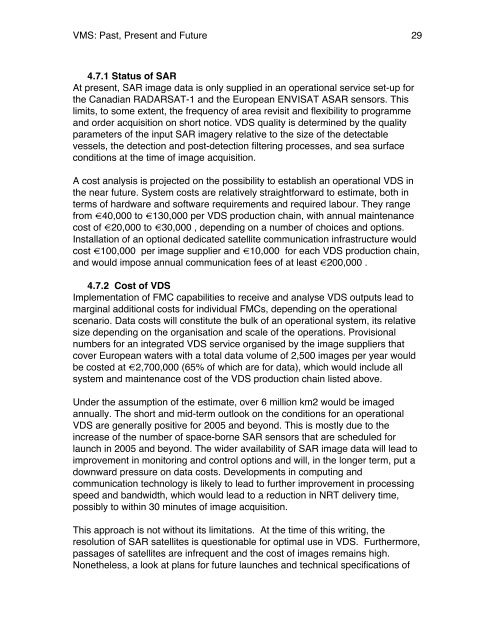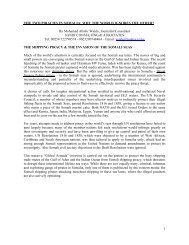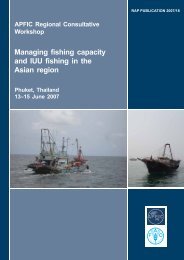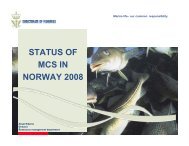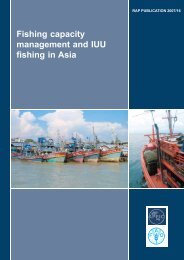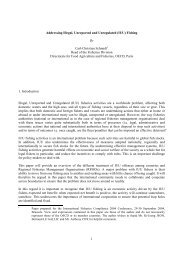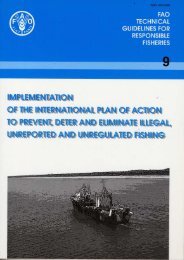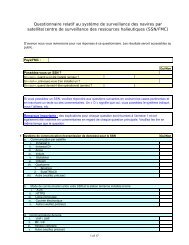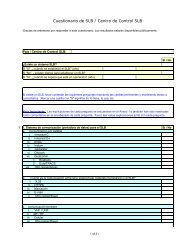Fishing Vessel Monitoring Systems: Past, Present and Future
Fishing Vessel Monitoring Systems: Past, Present and Future
Fishing Vessel Monitoring Systems: Past, Present and Future
Create successful ePaper yourself
Turn your PDF publications into a flip-book with our unique Google optimized e-Paper software.
VMS: <strong>Past</strong>, <strong>Present</strong> <strong>and</strong> <strong>Future</strong> 29<br />
4.7.1 Status of SAR<br />
At present, SAR image data is only supplied in an operational service set-up for<br />
the Canadian RADARSAT-1 <strong>and</strong> the European ENVISAT ASAR sensors. This<br />
limits, to some extent, the frequency of area revisit <strong>and</strong> flexibility to programme<br />
<strong>and</strong> order acquisition on short notice. VDS quality is determined by the quality<br />
parameters of the input SAR imagery relative to the size of the detectable<br />
vessels, the detection <strong>and</strong> post-detection filtering processes, <strong>and</strong> sea surface<br />
conditions at the time of image acquisition.<br />
A cost analysis is projected on the possibility to establish an operational VDS in<br />
the near future. System costs are relatively straightforward to estimate, both in<br />
terms of hardware <strong>and</strong> software requirements <strong>and</strong> required labour. They range<br />
from ¤40,000 to ¤130,000 per VDS production chain, with annual maintenance<br />
cost of ¤20,000 to ¤30,000 , depending on a number of choices <strong>and</strong> options.<br />
Installation of an optional dedicated satellite communication infrastructure would<br />
cost ¤100,000 per image supplier <strong>and</strong> ¤10,000 for each VDS production chain,<br />
<strong>and</strong> would impose annual communication fees of at least ¤200,000 .<br />
4.7.2 Cost of VDS<br />
Implementation of FMC capabilities to receive <strong>and</strong> analyse VDS outputs lead to<br />
marginal additional costs for individual FMCs, depending on the operational<br />
scenario. Data costs will constitute the bulk of an operational system, its relative<br />
size depending on the organisation <strong>and</strong> scale of the operations. Provisional<br />
numbers for an integrated VDS service organised by the image suppliers that<br />
cover European waters with a total data volume of 2,500 images per year would<br />
be costed at ¤2,700,000 (65% of which are for data), which would include all<br />
system <strong>and</strong> maintenance cost of the VDS production chain listed above.<br />
Under the assumption of the estimate, over 6 million km2 would be imaged<br />
annually. The short <strong>and</strong> mid-term outlook on the conditions for an operational<br />
VDS are generally positive for 2005 <strong>and</strong> beyond. This is mostly due to the<br />
increase of the number of space-borne SAR sensors that are scheduled for<br />
launch in 2005 <strong>and</strong> beyond. The wider availability of SAR image data will lead to<br />
improvement in monitoring <strong>and</strong> control options <strong>and</strong> will, in the longer term, put a<br />
downward pressure on data costs. Developments in computing <strong>and</strong><br />
communication technology is likely to lead to further improvement in processing<br />
speed <strong>and</strong> b<strong>and</strong>width, which would lead to a reduction in NRT delivery time,<br />
possibly to within 30 minutes of image acquisition.<br />
This approach is not without its limitations. At the time of this writing, the<br />
resolution of SAR satellites is questionable for optimal use in VDS. Furthermore,<br />
passages of satellites are infrequent <strong>and</strong> the cost of images remains high.<br />
Nonetheless, a look at plans for future launches <strong>and</strong> technical specifications of


